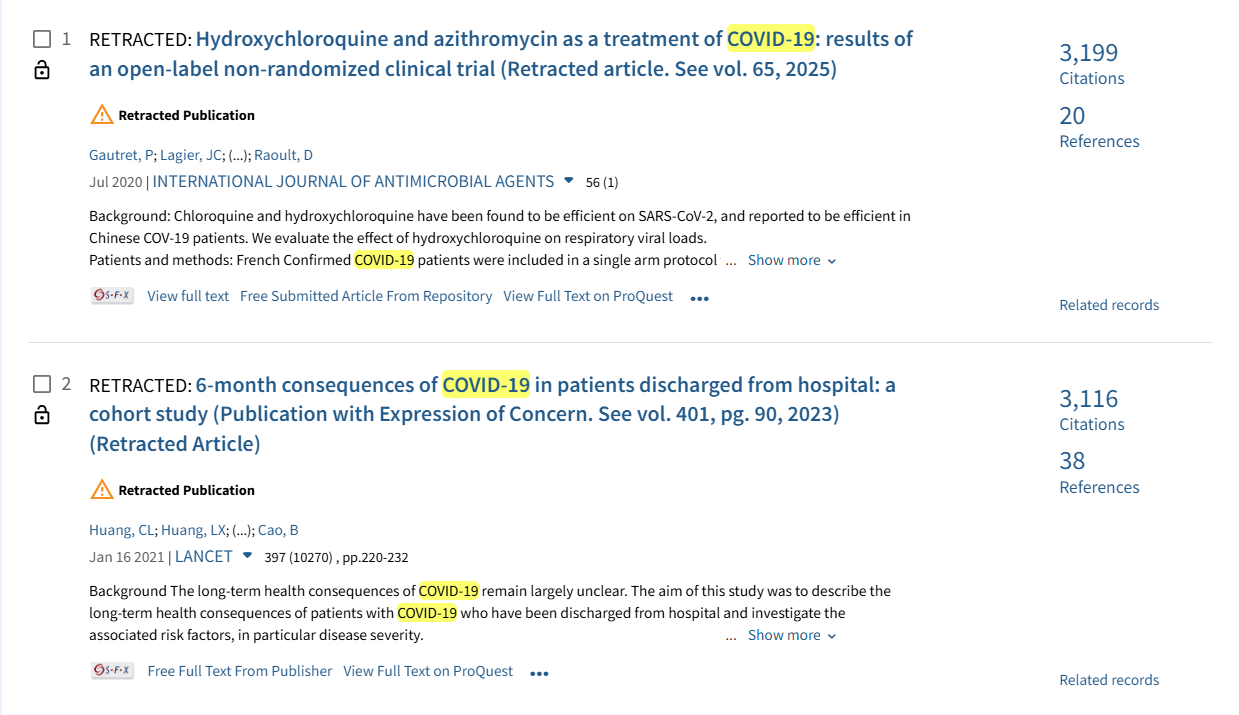
Clarivate highlights retraction information across products so that researchers can identify retracted publications and ensure the integrity of their work throughout the research process.
The number of retractions in scholarly publishing has grown in recent years, with over 13,000 retractions recorded in 2023 alone, according to the Retraction Watch database. While this uptick partly reflects improved detection and reporting mechanisms, it also highlights increasing threats to research integrity.
The issue has grown so prominent that even mainstream media is covering it. For example, The New York Times reports that mounting pressure on researchers to publish frequently and secure funding has created fertile ground for paper mills, making it harder for journals to maintain quality and integrity.
One of the most troubling aspects of retractions is their lingering influence. So-called “zombie papers” — retracted articles that continue to be cited as valid research — pose a serious threat to the integrity of the scientific record. A recent study published in Accountability in Research found that papers retracted for fraud were still being cited years later, often without any mention of their retracted status. This underscores the urgent need for better systems to flag and communicate retractions across the research lifecycle.
Through our products, partnerships, and community engagement, we are committed to addressing this challenge and enabling researchers to navigate the complexities of the scholarly record with confidence.
Our commitment to safeguarding research integrity
At Clarivate, we believe that research integrity is a shared responsibility — one that requires collaboration, transparency and innovation. We demonstrate our commitment to strengthening the research ecosystem not only through active participation in shaping community standards, but also by embedding integrity directly into the tools that researchers depend on every day. This integrated approach ensures that our efforts to uphold research integrity are both principled and practical, fostering a trustworthy scholarly environment.
Retractions correct the scholarly record when necessary, but these retractions must also be clearly and consistently conveyed across all relevant tools. As a member of the NISO Standing Committee for the Communication of Retractions, Removals, and Expressions of Concern (CREC), we collaborate with publishers, librarians, and technology providers to help define best practices for communicating retractions and related updates. The committee’s work culminated in the publication of NISO RP-45-2024, a recommended practice that outlines how retractions, removals, and expressions of concern should be identified, displayed, and disseminated across platforms.
Building retraction awareness into the research process
These community guidelines inform how we build and enhance our products, ensuring researchers are supported with trustworthy information throughout their workflows. The Web of Science platform includes clear flags for retracted publications, expressions of concern, and withdrawn articles. These indicators are prominently displayed in search results and article records, helping researchers quickly identify potentially problematic content.

Figure 1: Retraction flags on Web of Science search results
To provide even more context, we’ve integrated data from Retraction Watch, allowing users to view detailed retraction reasons directly within the Web of Science interface. This level of transparency empowers researchers to make informed decisions about whether and how to engage with retracted work. In addition to clearly flagging retracted papers, we also display the number of retracted articles in Times Cited counts on the platform, providing insight into the credibility of a paper’s citation network.

Figure 2: Detailed information from Retraction Watch displayed on Web of Science records
For researchers using the AI-powered Web of Science Research Assistant, responses exclude retracted papers, ensuring that the tool does not perpetuate the use of falsified or fraudulent research to build scientific understanding.
Staying current as the scholarly record evolves
Retraction awareness doesn’t stop at discovery. We’ve extended these safeguards into EndNote, our reference management tool, to ensure that researchers are alerted to retractions throughout the writing and publishing process.
Through our integration with Retraction Watch, EndNote:
- Automatically creates a temporary “Retractions” group when retracted papers are identified in a user’s library.
- Displays an expandable “Retracted publication” alert with detailed information.
- Shows warnings next to retracted references during citation insertion and formatting in Microsoft Word.
These features are designed to prevent outdated or invalid research from being incorporated into new publications. It’s not enough to check a paper once — researchers need up-to-date alerts at every stage of their work.
Accounting for retractions in journal metrics
Our commitment to research integrity extends to the metrics, indicators, and visualizations we include in analytics tools that researchers rely on, such as the Journal Impact Factor (JIF) in the Journal Citation Reports (JCR). In addition to the rise in retractions, we have also observed signs of shorter retraction timelines. Although retracted articles currently represent a very small fraction of the scholarly record, these evolving trends signal the need for safeguards to maintain the integrity of research metrics.
Knowing that researchers rely on the JIF to make decisions about their work, we introduced a new policy for JIF calculations. Starting with the JCR 2025 release (2024 data), we exclude citations to and from retracted content when calculating the JIF numerator to prevent these citations from contributing to widespread distortions in the JIF. Retracted articles are still included in the article count (JIF denominator), maintaining transparency and accountability.
Building on a solid foundation
By surfacing detailed retraction information during discovery, embedding alerts throughout the research and writing process, and factoring retractions into journal metrics, we help users make informed decisions that protect their work. Transparency and empowerment go hand in hand: when researchers have access to clear information about the literature they rely on, they’re better equipped to advance solid, reliable research.
At Clarivate, our goal is to support researchers in building knowledge that stands the test of time. By providing accurate, timely, and contextualized information about retractions, we help protect not only the integrity of the scholarly record but also the reputations and careers of researchers who rely on it.
Learn more about the trust markers we’ve built into your research process.









